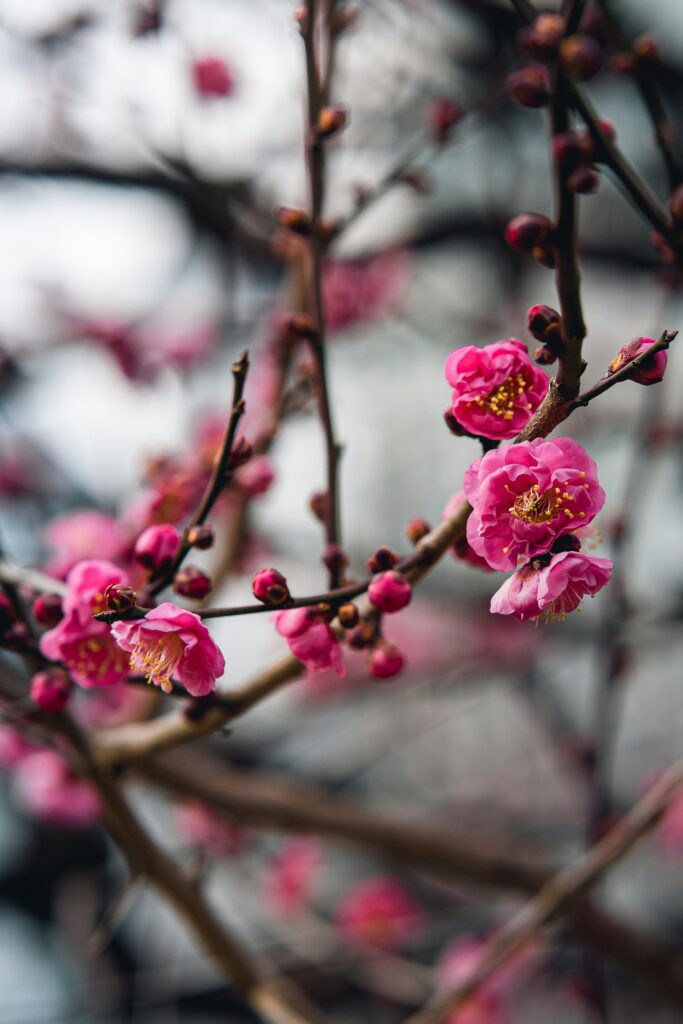From my studio window, a lone cherry tree sits in the garden, its branches still bare against the pale March sky. Every morning, I look for the first hint of petals — those fragile, fleeting signs that spring is returning. There’s a quiet tension in this waiting, like we’re all holding our breath, caught between winter’s stillness and the sudden rush of green that’s sure to come. It’s this in-between moment that artists have always tried to pin down: when the world feels paused, but you know it’s about to change.

Few cultures have articulated this tension as poetically as the Japanese, whose concept of mono no aware (物の哀れ) — the pathos of impermanence — permeates their artistic tradition. Take Katsushika Hokusai, whose 1833 woodblock print Cherry Blossoms at Yoshino belongs to his celebrated Snow, Moon, and Flowers (Setsugekka) series — a triptych distilling nature’s eternal motifs into meditative simplicity. Here, Hokusai strips Yoshino’s famed cherry groves to their essence: the sacred mountain’s slopes rise in muted gradients, while clusters of blossoms hover like weightless clouds, their pale pink petals rendered with a restraint foreign to his more kinetic works. Unlike the Thirty-Six Views of Mount Fuji, where the volcano often anchors scenes of human industry or churning seas, this print is devoid of narrative. There are no fishermen battling waves, no pilgrims on winding paths — only the silent dialogue between blossoms and stone. Hokusai’s linework is deliberate but unforced, echoing the disciplined minimalism of waka poetry. The blossoms, though fleeting, are not fragile; their repetition across the mountainside suggests cyclical return, a rhythm deeper than individual transience. This is spring not as eruption but as quiet affirmation, a reminder that beauty persists not despite impermanence, but because of it.
In stark contrast, Isaac Levitan’s Spring in Italy (1890) embraces spring’s vivacity with a chromatic audacity rare in his oeuvre. The canvas brims with the luxuriant light of the Italian countryside: a cerulean sky, the emerald tree canopies offset by the blush of blossoms crowding the foreground. Levitan, more commonly associated with the brooding lyricism of Russian landscapes, here adopts an impressionistic fluency. Dappled strokes of lemon-yellow and ochre animate wildflowers carpeting the hillside, while a sunlit path, rendered in creamy whites and pinks, winds toward a distant farmhouse. The air seems to hum with warmth, the paint itself vibrating with the energy of renewal. Yet even in this idyll, Levitan’s sensitivity to transience lingers. The blossoms, though riotous, are tinged with impermanence, their pink hues fading into the bleached earth. This is spring as fleeting abundance, a momentary convergence of light and life, framed by an artist acutely aware of its brevity.
Spring, in art as in life, defies complacency. It is both a beginning and a reminder of endings, a cycle that demands engagement rather than passive admiration. As I return to my window, I note the cherry tree’s first open blossoms, their petals trembling in the wind. They will not last, nor should they. Their brevity is what makes them urgent, what compels us to pay attention.
In our current age, where algorithms flatten time into endless scrolls and crises loom perennial, spring’s cyclical rhythm feels radical. It insists that endings are necessary for rebirth, that dormancy is not death but preparation. The artists who channel this truth — whether through a single brushstroke or a clash of metal and bloom — do not merely depict nature. They mimic its logic, creating works that breathe, falter, and revive. To witness spring is to be humbled; to render it in art is to join a conversation centuries old, yet forever new.
The buds outside my window will soon give way to leaves, then to shade, then to bare branches once more. But for now, they hold the light differently — a transient, luminous green. It is enough.
